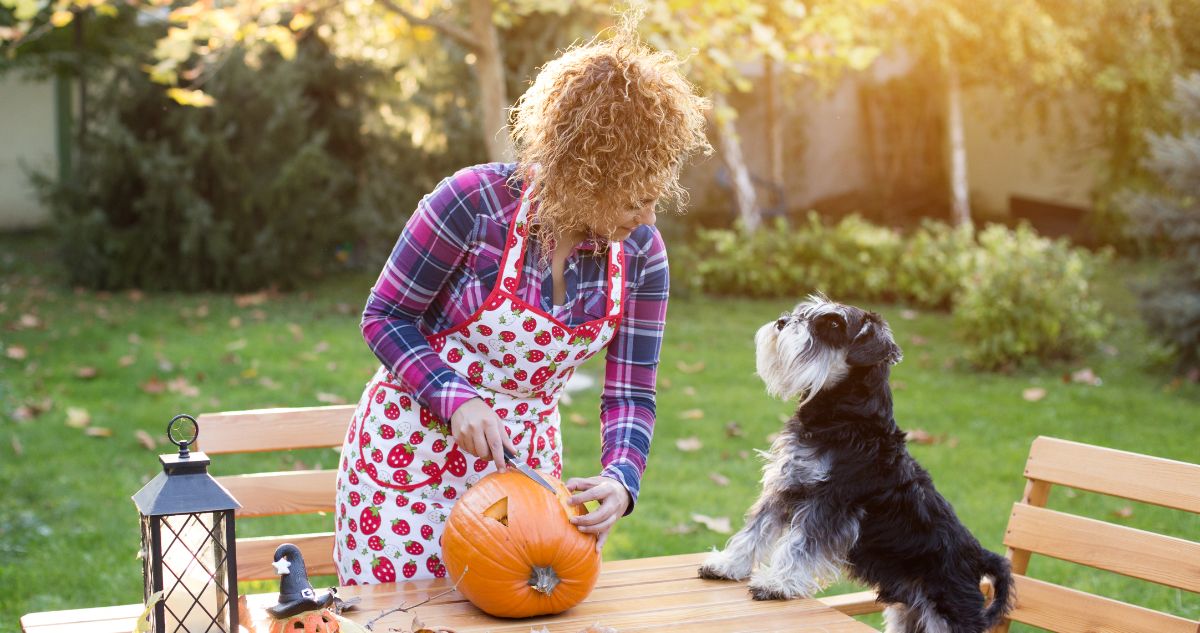Halloween can be a fun time for dogs and kids to dress up and go to a party or hand out candy. However, for dogs prone to anxiety or phobias, October is a frightening month, filled with monsters in every house (literally!), strange sounds and… Wow! For the many people who come to the door.
Help your dog cope with this scary season with these training and management tips.
before halloween night
Dress
Get your dog used to the idea of children and people in costumes.
- Start with easy costumes – a funny hat, furry coat, funny sunglasses, etc. – and build up to full costumes with masks.
- It’s easier for the dog if you wear the costume in front of them rather than looking at them awkwardly from across the room.
- Immediately begin giving your dog treats and saying “good” to him while he is eating them.
- Approach your dog slowly, keeping your body away from him (so don’t walk directly toward him), constantly offering him treats.
- If your dog comes to you, great! Pet them and feed them delicious things.
- If they don’t do this, don’t pressure your dog! Don’t walk right by him.
- If your dog doesn’t eat food, runs away and hides, or shows other signs of stress or fear, leave. Wait 3 minutes, if your dog is calm, try again. If they are not calm, you may need to make the costume less scary (to the dog).
Dressing up your dog can also be fun, but only if your dog is willing. Don’t add more stress to your dog by forcing him to wear clothes.
sights and sounds
Lots of neighborhoods now decorate for Halloween, which means your daily walk may be filled with big decorations, scary motion-sensing animated features, and strange lights.
- If you have decorations yourself, take advantage of them by doing some Look At That (look at something scary, get a treat) training before leaving your house. Present the items one by one to your dog for investigation.
- Take your dog outside during the day when decorations are easier to see, and most animated/lighted features will be turned off.
- When your dog sees or goes near any of these decorations, give him cookies. Be careful not to destroy any neighbor’s property. Your dog doesn’t need to go up and smell it, but just look at it and not be concerned.
- Then walk your dog in the evening, repeat the cookie process.
- Finally, walk your dog at night, repeat the cookie process.
doorbell/knocker
If your dog has a problem with the doorbell and/or knocking, you can give him a task to help him handle Halloween night (such as going to his kennel, going to the mat, going to a given location Lie down) . However, unless you’re really dedicated to practicing this entire month, you probably won’t be able to prepare treats for a night with this much activity.
Instead, just work on desensitizing yourself to the sound. Have someone knock on the door or ring the doorbell while you are throwing out the cookies. Remember Pavlov’s dogs? You’re basically doing the same thing with the doorbell and knocker that it did with the doorbell. This way, your dog will expect a treat when the bell rings or there is a knock on the door.
This practice also helps because your dog learns that just because they hear that noise, it doesn’t mean there’s someone at the door, helping them relax a bit.
Halloween night
It’s a big night! Make sure you have plenty of treats for the dog to use as a reward. However, this is not the night to let the timid dog try to overpower things. If you’ve been working with your dog all month and they’re still afraid of things, you need some management for the night.
For the (still) frightened dog:
- Take your dog out for a walk in the morning, before the trick-or-treaters come out.
- Keep them in a room away from the front door.
- Give them a fun toy, chew bone, etc.
- Turn on the TV or radio to provide some “white noise.”
- Post a note on your door asking children not to ring or knock on the doorbell. Instead, either leave the candy on the porch, sit with it on the porch, or leave your door open.
If your dog responded well to your work before Halloween, keep him company with you to make sure all these strange things and people mean treats. But don’t overdo it. If your dog seems a little stressed, don’t make him sit there for hours. Pay attention to your dog when they’ve had enough, but keep them in another room with a Halloween treat.
Above all, stay safe and monitor your dogs for signs of stress. Stressed and scared dogs bite, and you don’t want your dog to bite a child or parent out of fear. Halloween is fun, but it’s not for every dog. If you think there’s a chance your dog won’t be able to enjoy the festivities, it’s better to leave him alone than have the unthinkable happen.
And remember, no candy for the dog! Give them dog cookies or a chew bone instead.

